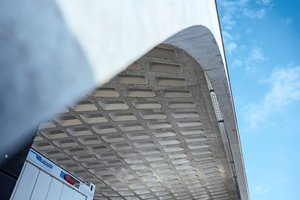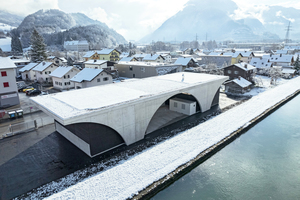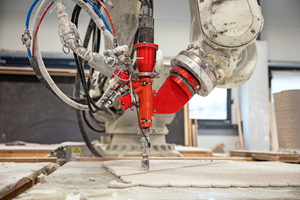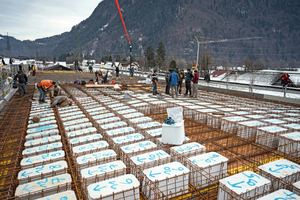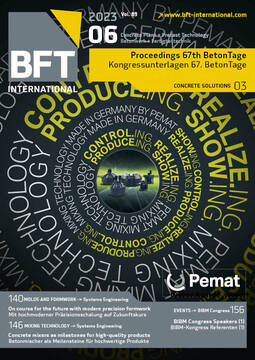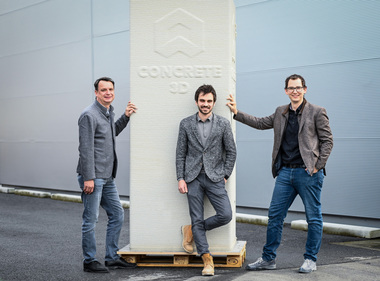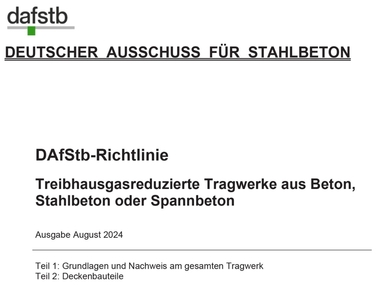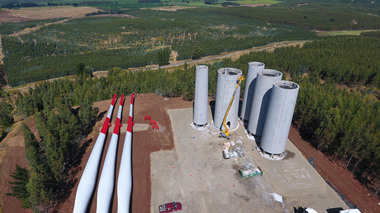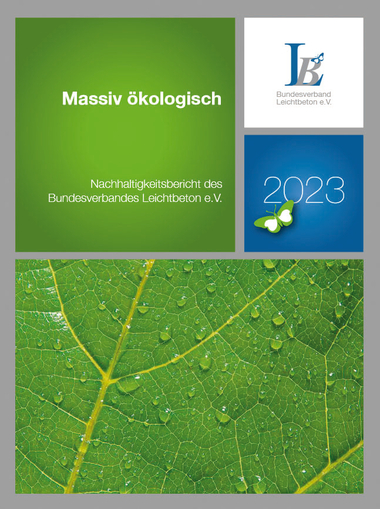Bludenz recycling yard: Concrete 3D realized concrete ceiling weighing a third less
The Bludenz recycling yard on Klarenbrunnstraße being just completed features a particular flat roof: It is 32.5 % lighter than comparable concrete roof slabs. In this way, 33 tons of greenhouse gases that are harmful to the climate were saved in the production process. This is possible thanks to the“block-out elements“ of the Concrete 3D start-up company.
The production of cement is the root cause of the large carbon footprint of concrete. „Saving material is the order of the day,“ Philipp Tomaselli points out. The new recycling yard situated in Bludenz-Klarenbrunn provided a good chance for a showcase project to the general manager of the Walgau-based Tomaselli Gabriel construction company.
Through the company specialized in concrete 3D printing, Concrete 3D, a connection with TU Graz was made: „3D printing enables a smart use of concrete, completely without formwork,“ emphasizes Georg Hansemann, project assistant at the Institute of Structural Design (ITE – Institut für Tragwerksentwurf) of TU Graz. „The technique allows the realization of totally new geometries, without any waste, which are ideally suited for saving concrete and steel,“ the scientist points out.
Client Werit, architect Marcus Ender and not least the city of Bludenz as user were impressed by the proposal of a climate-friendly waffle slab: „Apart from the fitness for purpose, sustainability was above all an important issue for us as the future tenant. The innovative construction method protects the environment and climate. The new recycling yard is a showcase project that brings us, as a so-called e5 city, also closer to the goal of our #MissionZeroBludenz,“ states mayor Simon Tschann. The structural engineers of GbD located in Dornbirn with the collaboration of the ITE provided for the concrete-saving construction.
Lightweight and climate-friendly solution
The idea is as simple as impressive: The installation of permanent formwork from the 3D printer saves material and emissions. With a software especially acquired for this purpose, Gbd calculated the 792 block-out elements – each one of a kind – for the flat roof covering 717 m². Concrete 3D printed these elements using over 60 tons of concrete and a printing path with an overall length of 210 km. The elements weighing up to 80 kg were numbered, delivered to the construction site, positioned onto the formwork by means of a total station, reinforcement steel was inserted between them and the whole structure was filled with concrete. The result: A roof slab with a weight reduced by a third, whose manufacture emitted 24.4 % less greenhouse gases.
World‘s largest construction of this kind
The pilot project was very informative for all those involved: „For us it is a reference for the potential of digitalization in the construction process and sustainability in solid construction,“ points out Philipp Tomaselli, general manager of Tomaselli Gabriel Bau. The flat roof completes the design of architect Marcus Ender: It rests on two supporting arches, spanning two wooden halls. The design options of the technology convince him: „The course of the forces becomes visible by the shape and position of the block-outs.“
„The construction faced us with several challenges, from the positioning of the block-outs to inserting the reinforcement through to concreting,“ states site foreman Daniel Burtscher (Tomaselli Gabriel Bau). The practical experiences gained on the construction site are pivotal for the structural engineers of Gbd and TU Graz, too: „The roof slab is the world‘s largest construction of this kind until now and provides important findings in order to spread the technology further, to save material and to protect the climate,“ emphasizes Georg Hansemann.
Great potential
The additional efforts for handling and logistics are compensated by material savings and the extented structural options. Moreover, there is an additional environmental aspect: „The construction consists of concrete and steel only and does not need any plastics – unlike other alternatives,“ states Tomaselli. Therefore, it can be reused entirely at the end of the service life – a recyclable product. As far as the emissions are concerned, Hansemann still sees room for improvement: „The use of low-carbon concrete allows saving 39 % of greenhouse gases.“ There is also potential in the process: „Sooner or later, we will print on the construction site directly,“ Michael Gabriel of Concrete3D is convinced.
CONTACT
Concrete 3D GmbH
Bundesstraße 12
6714 Nüziders/Austria
+43 5552 62300 229
Tomaselli Gabriel Bau, Nüziders
Bundesstr. 12
6714 Nüziders/Austria
+43 5552 62300

